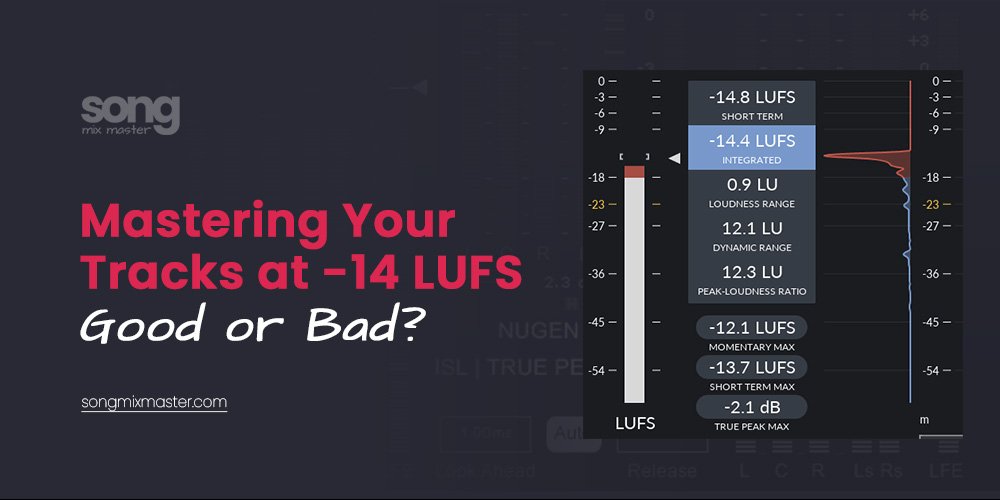Mastering
Mastering Your Tracks at -14 LUFS: Good or Bad?
As an audio engineer, the subject of mastering levels is always a hot topic on different audio forums, Reddit, or Facebook groups. One question that often arises is whether mastering tracks at -14 LUFS (Loudness Units relative to Full Scale) is a good practice.
Let’s delve into this, considering the technical aspects and industry standards.
Understanding LUFS and Loudness
LUFS is a unit of measurement that reflects perceived loudness, crucial in the digital age, especially with the rise of streaming platforms.
Also read: What Are LUFS? Why Are LUFS Important In Mastering?
These platforms, such as Spotify, Apple Music, and YouTube, employ loudness normalization to ensure consistent playback levels across various tracks. Spotify, for instance, recommends mastering at -14 LUFS.
But is this optimal for all music genres and contexts?
The -14 LUFS Standard

Also see: My Selection Of Best Plugins for Measuring LUFS
The recommendation of -14 LUFS comes from a desire to standardize playback levels, minimizing the jarring volume differences between tracks in a playlist. This level is especially aimed at creating a comfortable listening experience for users.
However, this standard is relatively new, emerging around 2011, whereas digital music production has been evolving since the 1980s.
Comparing Loudness Levels
When we look at commercial releases in genres like Rock, Pop, Hip Hop, and EDM, it’s evident that most are mastered much louder than -14 LUFS. Here are some examples:
- Coldplay – My Universe (2021): -7.8 LUFS
- Taylor Swift – You Need To Calm Down (2019): -7.4 LUFS
- Dua Lipa – Levitating (2020): -5.7 LUFS
These tracks are significantly louder, often around -7 to -8 LUFS, indicating a trend towards louder masters in commercial music.
The Impact of Mastering at -14 LUFS
Mastering at -14 LUFS can indeed make your track sound quieter compared to other commercial releases when loudness normalization is not applied, such as on certain streaming platforms or in environments where normalization is disabled.
This can be jarring and disappointing, particularly for new artists comparing their work with top-charting hits.
The Role of Dynamics
It’s crucial to remember that louder does not always mean better. Dynamics play a significant role in the emotional impact of a track. Classical music, for instance, often measures below -14 LUFS because it prioritizes dynamic range over loudness.
The dynamic contrast is integral to its genre, creating a rich and immersive listening experience.
Practical Recommendations
Given the diversity in mastering practices and the variation in platform normalization, here are some recommendations:
- Study Professional References: Analyze tracks similar to your genre and understand their loudness levels and dynamic ranges.
- Focus on the Mix: A well-balanced mix with clear elements will sound better at any loudness level. Pay attention to the quality of your recordings, arrangement, and performance.
- Set a Monitoring Level: Use a consistent monitoring level during mixing and mastering. This helps in making informed decisions about loudness and dynamics without relying solely on meters.
- Trust Your Ears: Ultimately, your ears are the best judge. Regularly compare your mix to reference tracks and trust your auditory perception.
- Understand Your Platform: Know the target loudness normalization for each streaming platform your music will be on. This can inform your mastering decisions.
Also read: Mastering for Spotify: Achieving the Perfect LUFS Level
In Conclusion
Mastering at -14 LUFS is not inherently bad or good. It depends on the context of your music, the genre, and the platforms you are targeting. While -14 LUFS is a safe and recommended level for streaming, it’s essential to consider the genre-specific expectations and the listening environment.
The goal is to find a balance between maintaining dynamic range and achieving a competitive loudness level that suits your artistic vision and meets the listener’s expectations.
I told you at the beginning that I am active on several forums and groups about mixing, mastering, and music production, so below I leave you a list of some communities where you can also join, share your experiences, and gain valuable insights to improve your music journey:
- Facebook: Music Production, Mixing and Mastering
- Facebook: Mixing & Mastering
- Facebook: Home Studio
- Facebook: Mastering Pros
- Facebook: FL Studio Producers (My group)
- Facebook: Studio One (My new group)
- Facebook: Logic Pro 11 (My new group)
- Facebook: Pro Tools (My new group)
- Reddit: r/mixingmastering
- Reddit: r/musicproduction
- Reddit: r/audioengineering
- Forum: Gearspace Mastering
- Forum: KVR Production Techniques


Disclaimer: Any references to any brands on this website/webpage, including reference to products, trademarks, brands and companies, are provided for description purposes only. We don't have any association with or endorsement by these brands or companies. Some of the links on our blog may be affiliate links. This means if you click on these links and make a purchase, we may earn a commission at no extra cost to you.
Need Professional Mixing & Mastering?
You may also like to read...
15 Best De-Esser Plugins For Better Sibilance Control
5 Best Compressor Plugins for Vocal Parallel Compression
How Does Temperature Affect the Propagation of Sound?
Vocal Warm-Up: Preparing for a Pitch-Perfect Performance
5 Tips for Using The Reverb Effect in Music Production
How To Mix Hip-Hop Vocals in FL Studio Using Stock Plugins